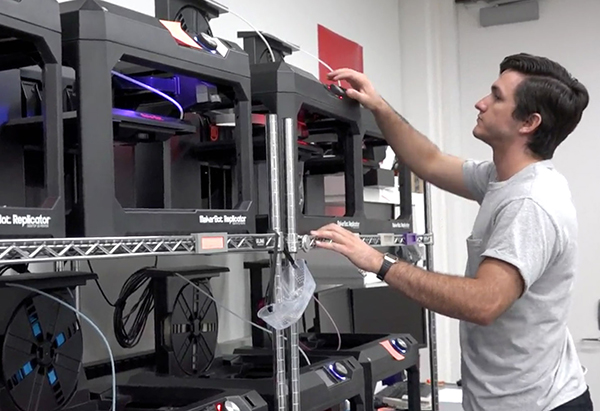CAASE20: Working in the Post-COVID World
As offices shutter, new doors open for remote collaboration, digital twins and 3D printing, say CAASE20 keynote speakers.

May 22, 2020
In the last three months, a menacing black swan appeared, upending many engineering projects and livelihoods. NAFEMS’s simulation conference CAASE20, cohosted by DE, was originally set to take place in Indianapolis, IN. It will still take place, but not onsite; due to the uncertainties and travel restrictions still in place, the conference has moved online (free for NAFEMS members to attend; nonmembers pay a modest fee).
For the foreseeable future, COVID-19 and the cataclysmic changes it has prompted are here to stay. To address the new normal, Marc Halpern from Gartner, and Peter Langsten from Predict Change will deliver a new CAASE20 keynote, making the case that “Simulation Governance is Key to Delivering Best-of-Class Products in the Age of COVID-19.”
Is it possible to implement “socially distant yet productive and collaborative design work”? The two presenters argue that, to make this happen, manufacturers must tackle a list of pressing priorities.
The Catalyst to Remote Work Protocols
In NAFEMS’s April issue of Benchmark magazine (free download for members), Halpern and Langsten cowrote an article titled, “Overcoming COVID-19 Obstacles” (pg. 62-66). In it, the authors point out, “strict social distancing will be with us anywhere from 6 weeks to 1.5 years, depending on the country affected, recurrences of COVID-19, or any other virus effects.”
The virus outbreak “accelerates the adoption of technologies and initiatives that allow for working with social distancing as a priority. Remote design and engineering, digitalization, automation, plus adoption of machine learning and robotic process automation (RPA) encourage a more productive social distancing work environment,” they add.
Since the travel restrictions went into effect, some tech companies have begun offering their remote collaboration and cloud-hosted software at a deep discount or for free. PTC began offering free licenses of Vuforia Chalk (through August 31), an AR-based remote-assistance software. The company is also offering free use of its cloud-hosted CAD product Onshape to qualifying COVID-19-related projects. Similarly, Graebert offers its browser-based DWG editor software ARES Kudo for free during the outbreak.
These initiatives are prompted no doubt by a desire to help sustain the clients’ engineering projects. But they also hint at the collaboration software industry’s recognition of the unexpected opportunity for recruitment afforded by the crisis.
An Opening for Digital Twins
In their article, Halpern and Langsten made several recommendations, including replacing physical prototypes with simulation and optimizing manufacturing with simulation.
“If reliable simulations were conducted remotely, businesses could reduce the amount of testing—including prototype testing—required. This would allow for reduced presence of workers in R&D and testing labs, enabling as sufficient amount of social distancing and reduced design costs,” they propose.
The impact of the slowdown in manufacturing during the shutdown cannot be underestimated, but the crisis also opens windows of opportunity for digital twin deployment. This means not just digital counterparts of parts and products but entire factories and systems.
According to Halpern and Langsten, “Simulating manufacturing operations offers insight into optimal placement, use, and scheduling of resources to ensure that the extent of human activities and the interactions of humans with other humans and their work environment remains safe from COVID-19 and OSHA (the US Occupational Safety and Health Administration) perspectives.”
3D Printing’s Time to Shine
On the eve of the crisis, witnessing the alarming PPE (personal protective equipment) shortage at hospitals, many tech firms, universities, maker communities, and creative individuals sprang into action. In many cases, the use of 3D printing turns out to be a quick and reliable way to kickstart production.

Examples of these include the AM (additive manufacturing) systems maker Stratasys’s initiative to print and distribute face shields; on-demand manufacturing service portal Fictiv’s launch of face shield production; the America Makes-led initiative to matchmake healthcare workers in need of PPE and those who can produce PPE; and more.
Halpern and Langsten also recommend expanded use of 3D printing to “[reduce] the degree of inter-dependencies across people to produce and deliver things.” They point out, “users must learn technical aspects of designing parts for 3D printing along with overcoming the challenges of using different types of 3D printers. Use of 3D printing service bureaus can be an alternative to printing 3D parts at-home or on premises.”
Shops are Closed; the Cloud is Open
The centerpiece of remote collaboration during the lockdown is the cloud, the ever-present virtual infrastructure in the public domain. Many regular team meetings have shifted from corporate boardrooms and conference rooms to Zoom, Skype, and WebEx, with participants signing on from their home offices and private residences.
This has exposed the paradoxical nature of corporate VPNs (Virtual Private Networks). The security measure once deemed essential in corporate settings turn out to be a hurdle in many cases for employees working from home.
“Feedback from engineers and designers shows mixed results on performance of engineering and design applications over a VPN. Sustained work beyond the immediate COVID-19 crisis requires greater compute power and network performance than that possible over a VPN. The cloud is the most practical and obvious source for that compute power, network bandwidth, and scalable storage,” observe Halpern and Langsten. “Data security is also a priority—particularly for industries with regulations mandating data protection,” the authors add.
For certain IP-sensitive industries, such as military contractors, automotive, and aerospace, the current crisis is a dilemma. To facilitate engineers working from home, the firms may need to revise their security policies, or reengineer their IT frameworks to encompass employees’ home computers. This blurs the line between private and professional equipment and raises new concerns over employers’ access to employees’ private data.
The authors conclude, “The post COVID-19 engineering environment will pose new demands on availability, integrity, usability of product data due to fundamental changes in the predictability of business operations, and requirements from product development, production and service activities.”
To register for CAASE20 Virtual, go to www.nafems.org/caase20.
More NAFEMS Coverage
Subscribe to our FREE magazine, FREE email newsletters or both!
About the Author
Kenneth Wong is Digital Engineering’s resident blogger and senior editor. Email him at [email protected] or share your thoughts on this article at digitaleng.news/facebook.
Follow DE





